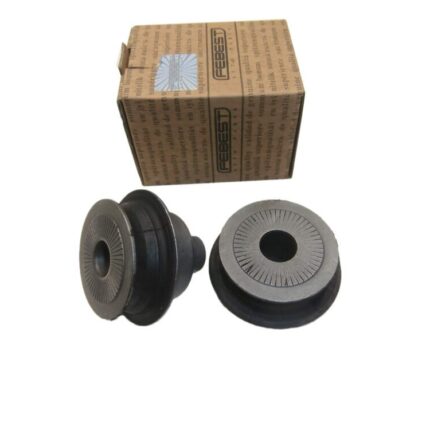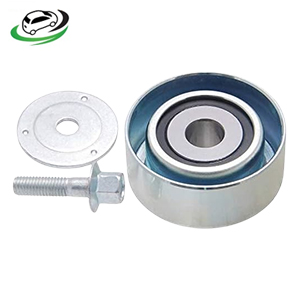-17%
Get Tensioner Pulley Hilux Vigo Hiace Fortuner 0187-KDN145
A tensioner pulley is a crucial component in a vehicle’s engine that helps maintain the correct tension in the drive belt or serpentine belt. Here’s an in-depth look at the function, importance, and signs of issues with a tensioner pulley:
Function of a Tensioner Pulley:
- Belt Tension Adjustment:
- The primary function of a tensioner pulley is to maintain proper tension on the drive belt or serpentine belt in the engine.
- It ensures that the belt remains tight enough to transmit power from the crankshaft to various engine components such as the alternator, water pump, power steering pump, and air conditioning compressor.
- Automatic Tension Adjustment:
- Unlike manual belt tensioning systems, which require periodic adjustment, a tensioner pulley automatically adjusts the tension of the belt.
- This automatic adjustment compensates for belt stretch over time, changes in temperature, and other factors that can affect belt tension.
- Prevention of Slippage:
- Correct tension prevents the drive belt from slipping on the pulleys of engine accessories.
- Slippage can lead to reduced efficiency of engine-driven components, such as reduced charging by the alternator or inadequate cooling from the water pump.
- Reduced Wear and Tear:
- Properly tensioned belts experience less wear and tear, leading to longer belt and pulley lifespan.
- It helps in maintaining the overall reliability and performance of the engine’s accessory components.
Components of a Tensioner Pulley:
- Pulley: The tensioner pulley itself is a wheel with a grooved rim that allows the belt to run smoothly.
- Tensioner Arm: Connected to the pulley, the tensioner arm applies force to adjust the position of the pulley.
- Spring or Hydraulic Mechanism: Provides the force that applies tension to the belt, ensuring consistent tension as the engine operates.
Signs of Issues with a Tensioner Pulley:
-
- Squealing or Squeaking Noise:
- A common early sign of a failing tensioner pulley is a high-pitched squealing or squeaking noise coming from the engine bay.
- This noise typically occurs when the engine is running and may vary with engine speed.
- It indicates that the drive belt is slipping due to inadequate tension from the tensioner pulley.
- Grinding or Rattling Sounds:
- As the tensioner pulley wears further or if it becomes misaligned, you may hear grinding or rattling noises.
- These noises often indicate that the pulley is not rotating smoothly or that it may be hitting other engine components due to excessive play.
- Visible Wear or Damage:
- Inspect the tensioner pulley visually for signs of wear, such as cracks, chips, or grooves in the pulley itself.
- Also, check for damage to the tensioner arm or any mounting brackets associated with the pulley.
- Visible wear or damage suggests that the pulley is nearing the end of its service life and may need replacement.
- Belt Misalignment:
- A failing tensioner pulley can cause the drive belt to become misaligned with other pulleys in the engine.
- You may notice the belt not running smoothly on the pulleys or slipping off its intended path.
- Belt misalignment can lead to increased friction, accelerated wear on the belt, and potential damage to other engine components.
- Loose or Slack Belt:
- If the tensioner pulley fails to maintain proper tension on the drive belt, the belt may appear loose or have excessive slack.
- A loose belt can cause accessories like the alternator, water pump, or power steering pump to operate inefficiently or fail altogether.
- Failure to Maintain Belt Tension:
- In severe cases of tensioner pulley failure, the tensioner may no longer be able to maintain consistent tension on the drive belt.
- This can result in complete loss of power to engine accessories, leading to a breakdown or loss of vehicle functionality.
- Check Engine or Battery Warning Light:
- If the drive belt controls components like the alternator or water pump, failure of the tensioner pulley can trigger warning lights on the dashboard.
- Watch for indicators like the check engine light, battery warning light, or temperature warning light, which may signal issues with engine accessories.
- Squealing or Squeaking Noise:
Replacement and Maintenance:
- Replacement Interval: The tensioner pulley is typically replaced as part of scheduled maintenance or when signs of wear or failure are detected.
- Professional Inspection: If you suspect issues with the tensioner pulley, have a qualified mechanic inspect the entire belt drive system to diagnose and address any underlying problems.
- Belt Replacement: Often, it is advisable to replace the drive belt along with the tensioner pulley to ensure optimal performance and reliability.
Follow us on Facebook For more parts.



